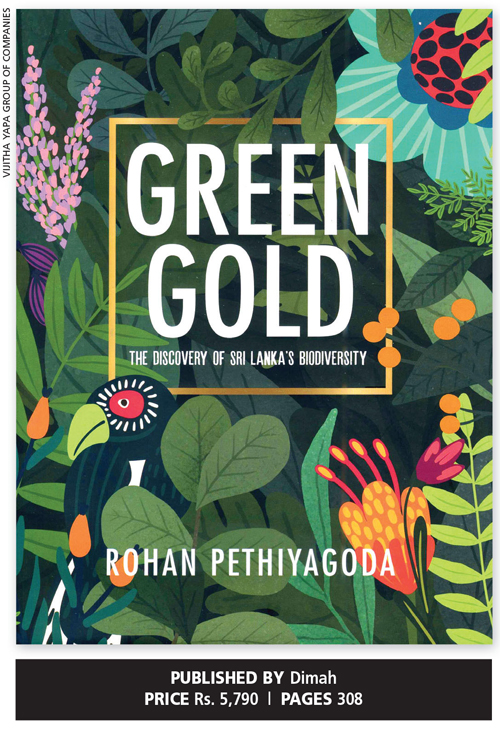BOOKRACK

Renowned Sri Lankan scientist Dr. Rohan Pethiyagoda has once again delved into the island’s celebrated biodiversity. And in dedicating this tome, the Rolex Laureate aptly reproduces a portrait of Swedish biologist Carolus Linnaeus.
For in his book Flora Zeylanica (published in 1747), Carl von Linné (a.k.a. Linnaeus) presented the first narration of natural history exploration in Sri Lanka.
Pethiyagoda’s book – Pearls, Spices and Green Gold: An Illustrated History of Biodiversity Exploration in Sri Lanka, which was first published in 2007 – has been revised with the CEO of Dilmah Dilhan Fernando offering to publish the updated edition.
One of the additions is a chapter on the history of rubber. Pethiyagoda says this is because colonial agriculture went hand in hand with “colonial exploration: each must be seen in the light of the other.”
He lays great emphasis on cinnamon, which since ancient times was associated with luxury and sensuality, and true cinnamon (cinnamomum verum) is endemic to the moist lowlands of southwest Sri Lanka.
Many of the 250 species of this genus, which are cultivated in several regions of the world today, have an aromatic bark from which the volatile oil containing cinnamaldehyde is extracted.
It is acknowledged that the cinnamon produced in Sri Lanka exudes a fragrance far superior to that of other species; which is why even today, Ceylon Cinnamon continues to fetch higher prices in the world market.
The quality of cinnamon greatly depends on the method of its curing and peeling. By tradition, it is the people of the ancient caste of Salagama who were engaged in this process for generations.
But there were some instances where unscrupulous traders imported cinnamon to Sri Lanka from other countries including Indonesia and reexported it, claiming that it was Ceylon Cinnamon.
Cinnamon has an interesting history. The Dutch tried unsuccessfully to grow it by collecting plants from the wild. Swedish botanist Carl Peter Thunberg visited Ceylon in 1777 and examined a large quantity of cinnamon, which was provided by the King of Kandy.
Thunberg was not impressed, however. He wrote in 1793: “Half of it was found to be adulterated and spoiled, tasteless and bad.”
If this happened with goods supplied officially by the king in the 18th century, it’s no wonder that even today, ministers of state are involved in supplying low quality products to the gullible masses!
Sri Lanka was also known for its pearl fisheries off Mannar. Roman naturalist Pliny the Elder in his book Natural History writes that Taprobane harvested “the most productive of pearls of all parts of the world.”
In 1881, our pearl fisheries fetched US$ 1 million (equal to 25 million dollars today) in revenue.
But British Governor Sir Robert John Wilmot-Horton wanted to impress his masters in London by claiming that he could raise more income from pearl fisheries. Wilmot-Horton then killed the goose that laid the golden eggs by having all the oysters fished up and destroyed a profitable industry.
We learn that to create the coffee industry, vast tracts of virgin forests were levelled as the British pushed ahead with their plans to grow more and increase their income. When the crop suffered a major blow due to the coffee rust fungus, tea proved to be manna from heaven.
With the destruction of forests in the highlands, Governor of Ceylon James Robert Longden wrote tragically that there were “no forests left of such value as to require or justify the creation of an expensive forest department”!
Pethiyagoda observes that if the coffee blight had not destroyed the industry, “the British might have become a nation of coffee drinkers.”
Another crop that was very successful in Sri Lanka was cocoa.
The author reproduces an advertisement by the famous Fry’s chocolate company, promoting chocolate powder from 100 percent Ceylon Cocoa. But the disadvantage of cocoa was that the crop could only be grown successfully in small areas.
Tea proved to be a lucrative industry for the British; and even today, Ceylon Tea is recognised as being among the best in the world.
I have only touched on a small part of this amazing book mainly due to the restraint of words in a one page column.
This publication should find a place on the bookshelves of all Sri Lankans. It’s a treasure house of amazing facts about our land meticulously researched.
In addition to the range of information contained in its pages, the book is lavishly illustrated with images of diverse specimens, and those who helped create the mystery and aura of our land.




